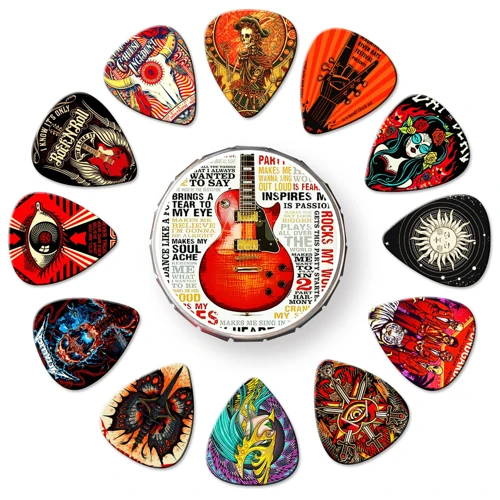Country music has a rich history and a unique sound that is loved by millions of people around the world. One of the things that sets country music apart is the use of unique materials for guitar picks. In this blog post, we will explore the world of unique materials for guitar picks and how they contribute to the distinctive sound of country music.
The Importance of Guitar Picks
A guitar pick is a small but essential tool for any guitar player. It allows the player to strum and pick the strings, creating the sound that is heard when playing the guitar. The material and shape of the pick can have a significant impact on the tone and playability of the guitar.
Traditional Guitar Picks
The most common material for guitar picks is plastic, which is inexpensive, durable, and easy to produce. Plastic picks come in a variety of thicknesses, shapes, and sizes, making them a versatile choice for many guitar players. However, for country music, many players prefer to use unique materials for their guitar picks.
Unique Materials for Guitar Picks
Country music guitar picks are often made from unique materials such as stone, wood, metal, and even bone. These materials can give the guitar a unique tone and feel that is not possible with traditional plastic picks.
Stone Guitar Picks
Stone guitar picks are made from materials such as agate, jade, and obsidian. These materials are known for their durability and unique visual appeal. Stone picks can produce a bright and clear tone, with a quick attack and a warm, full-bodied sound.
Wood Guitar Picks
Wood guitar picks are made from a variety of woods, including rosewood, ebony, and walnut. Wood picks can produce a warm, rich tone with a smooth attack. They are also known for their natural feel and comfortable grip.
Metal Guitar Picks
Metal guitar picks are made from materials such as stainless steel, brass, and copper. These picks can produce a bright, crisp tone with a fast attack and a long sustain. They are also known for their durability and resistance to wear.
Bone Guitar Picks
Bone guitar picks are made from animal bones, such as cow, buffalo, or camel. These picks can produce a warm, rich tone with a smooth attack. They are also known for their natural feel and unique visual appeal.
The Impact of Guitar Picks on Country Music
The use of unique materials for guitar picks is an essential part of the country music sound. These materials can give the guitar a distinctive tone and feel that is not possible with traditional plastic picks. They also allow the guitar player to express their individual style and personality through their choice of pick.
Famous Country Music Guitar Picks
Many famous country music guitar players have their own signature guitar picks made from unique materials. For example, the legendary guitar player Chet Atkins was known for using a stone pick made from a piece of his mother’s onyx ring. The country music superstar Brad Paisley uses a custom-made wooden pick made from a piece of his grandfather’s fence.
Where to Find Unique Guitar Picks
Unique guitar picks made from materials such as stone, wood, metal, and bone can be found at specialty music stores and online retailers. They are often more expensive than traditional plastic picks, but they offer a unique sound and feel that is worth the investment.
Looking to explore the world of guitar picks in country music? Check out our articles on top guitar straps for country music players, the history of guitar picks in country music, essential tips for acoustic country music players, proper ways to hold a guitar pick in country music, and incorporating hybrid picking techniques in country music for a deeper dive into this unique aspect of musical culture!
Conclusion
In conclusion, the use of unique materials for guitar picks is an essential part of the country music sound. These materials can give the guitar a distinctive tone and feel that is not possible with traditional plastic picks. They also allow the guitar player to express their individual style and personality through their choice of pick. Whether you are a beginner or a seasoned pro, exploring the world of unique guitar picks can help you find the perfect sound for your country music.



